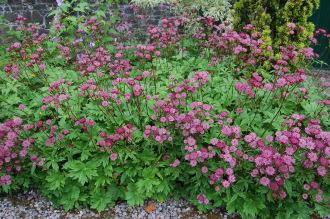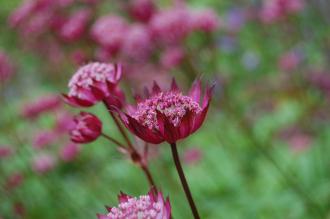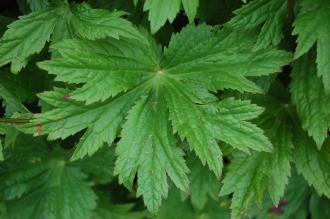
Astrantia ‘Hadspen Blood’ (16/06/2014, Dunvegan Castle, Isle of Skye, Scotland)
Position: Full sun to partial shade
Flowering period: Summer
Soil: Moist, well drained
Eventual Height: 75cm
Eventual Spread: 60cm
Hardiness: 5a, 5b, 6a, 6b, 7a, 7b, 8a, 8b, 9a, 9b
Family: Apiaceae
Astrantia major ‘Hadspen Blood’ is a deciduous herbaceous perennial with a clump forming habit. The mid green leaves are palmate with doubly serrate margins, up to 15cm long and 15cm broad. Its fragrant red/ purple flowers are umbrella-shaped, bristly, up to 3cm across.

Astrantia ‘Hadspen Blood’ Flower (16/06/2014, Dunvegan Castle, Isle of Skye, Scotland)
The species Astrantia major, commonly known as the Great Masterwort, Melancholy Gentleman or Hattie’s Pincushion, is native to Europe and western Asia. In its native habitat it is found in mountain meadows, grasslands, forests, clearings and beside streams. Astrantia major ‘Hadspen Blood’ is synonymous with Astrantia ‘Hadspen Blood’
The etymological root of the binomial name Astrantia is derived from the Latin astrum ’star’, referring to the star shaped flower umbels. Major is derived from the Latin meaning ‘greater’. Rubra is from the Latin meaning ‘red’.
The landscape architect may find Astrantia major ‘Hadspen Blood’ useful on the banks of riparian planting schemes including lakes an streams. It is also suitable for use as part of a prairie type planting schemes. It is a suitable perennial for us a part of a mixed herbaceous planting scheme.
Ecologically, Astrantia major ‘Hadspen Blood’ flowers are attractive to pollinating beetles and other insects.

Astrantia ‘Hadspen Blood’ Leaf (16/06/2014, Dunvegan Castle, Isle of Skye, Scotland)
Astrantia major ‘Hadspen Blood’ prefers moist, fertile, well-drained soils. It tolerates most pH of soil.
Astrantia major ‘Hadspen Blood’ requires little maintenance. The flowering stems may be cut back as they start to turn brown to encourage further flowering. Large clumps may be divided in spring, although they may take some time to establish as they do not like to have their roots disturbed.

